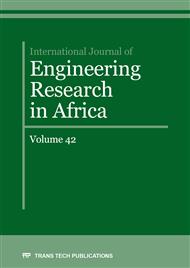[1]
Y. Shao, Physics and modeling of wind erosion. Springer, Atmospheric and oceanographic sciences library, volume 37, (pp.32-301), (2008).
Google Scholar
[2]
K. Wood, Blade repair: Closing the maintenance gap. Composites Technology, April, (2011).
Google Scholar
[3]
L. Remple, Rotor Blade Leading Edge Erosion – Real Life Experiences, Wind Systems, 22 October. (2012).
Google Scholar
[4]
3M, [Online]. Available: www.3M.com/wind. (2012).
Google Scholar
[5]
MD.Haag, Advances in leading Edge protection of wind turbine blades, conference proceeding LM Wind Power, Denmark, 4 February, (2013).
Google Scholar
[6]
E. Ferrer, X. Munduate, CFD predictions of transition and distributed roughness over a wind turbine airfoil. In: 47th AIAA aerospace sciences meeting. January, (2009).
DOI: 10.2514/6.2009-269
Google Scholar
[7]
N. Gregory, L. O'Reilly,. Low speed aerodynamic characteristics of NACA 0012 aerofoil section, including the effects of upper-surface roughness simulating hoar frost. Aeronautical Research Council reports and memoranda. London, UK (1973).
Google Scholar
[8]
M. Shafiee, M. Patriksson, A. Strömberg, An Optimal Number-Dependent Preventive Maintenance Strategy for Offshore Wind Turbine Blades Considering Logistics, Advances in Operations Research Volume, (2013).
DOI: 10.1155/2013/205847
Google Scholar
[9]
R. Ourahmoune, M. Salvia, T.G. Mathia, , N Mesrati, Surface morphology and wettability of sandblasted PEEK and its composites, Journal of Scanning, Volume 36, Issue 1, pages 64–75, January-February, (2014).
DOI: 10.1002/sca.21089
Google Scholar
[10]
M. Bederina, M. Gotteicha, B. Belhadj, R.M Dheily, M. Khenfer, M. Queneudec, Drying shrinkage studies of wood sand concrete- Effect of different wood treatments, Construction and Building Materials, Elsevier, volume 36, pp.1066-1075, November, (2012).
DOI: 10.1016/j.conbuildmat.2012.06.010
Google Scholar
[11]
J. H. McMasters, M. L. Henderson, Low-speed single-element airfoil synthesis. Technical Soaring 4, 2, 1–21, (1979).
Google Scholar
[12]
W. Chakroun, I. Al-Mesri, S. Al-Fahad, Effect of Surface Roughness on the Aerodynamic Characteristics of a Symmetrical Airfoil, Journal of Wind Engineering. Vol. 28, N°5, p.547 – 564, 2004.
DOI: 10.1260/0309524043028136
Google Scholar
[13]
G. Fortin, A. Ilinca, JL. Laforte, V. Brandi, A New Roughness Computation Method and Geometric Accretion Model for Airfoil Icing, Journal of Aircraft Vol. N°5, p.1 – 14, (2004).
DOI: 10.2514/1.173
Google Scholar
[14]
JE. Goodwin, W. Sage, GP. Tilly, Study of erosion by solid particles, Proceeding of the Institution of Mechanical Engineers, Vol. 184, p.279, 1969-1970.
DOI: 10.1243/pime_proc_1969_184_024_02
Google Scholar
[15]
AP. Harsha, MK. Ghosh, Erosion Studies of Short Glass Fiber-reinforced thermoplastic Composites and Prediction of Erosion Rate Using ANN, Journal of Reinforced Plastics and Composites June, vol. 29 no. 11, 1641-1652, (2010).
DOI: 10.1177/0731684409338632
Google Scholar
[16]
GW. Stachowiak, AW. Batchelor, Engineering Tribology, Amsterdam; Tribology Series, (1993).
Google Scholar
[17]
R.P.J.O.M. Van Rooij, WA. Timmer, Roughness sensitivity considerations for thick rotor blade airfoils, Journal of Solar Energy Engineering, 125, p.468–478, (2003).
DOI: 10.1115/1.1624614
Google Scholar


